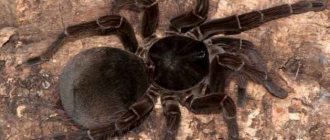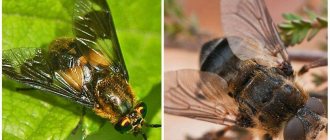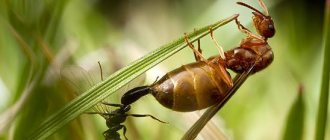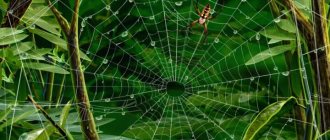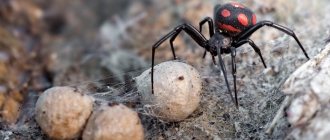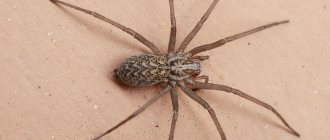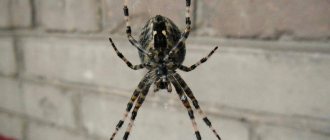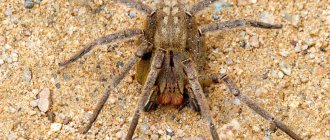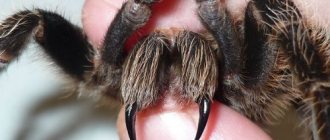We all often and everywhere deal with the environment and wildlife in particular. Plants and animals are present in our lives to one degree or another every day. And it's not always just cute little furry friends and nice flowers. Quite often we have to deal with less pleasant individuals, whom few can calmly tolerate. Probably everyone has already guessed that we will talk about insects and their small unpleasant legs. And in particular, about spiders, since recently quite interesting questions have arisen about the structure of their bodies.
For quite some time now, here and there, information has been constantly appearing that there are winged spiders . This is a very interesting fact, because it is not so easy to imagine a spider with wings. And even more so, to see exactly how its wing mechanism works. Should we naively trust this information?
You can trust rumors, but it is better to check everything and do your own research. This article will be devoted to the analysis of this topic. And, if you are interested in finding out how things really are with the wings of spiders, then be sure to proceed to reading the material presented below.
Research first
Selenops spiders are spiders that can fly. But how do they do it?
Selenops themselves are quite impressive in size; their body length can even reach several centimeters. And their usual and convenient habitat is the highest layers of tropical forests in South America. Their usual way of life includes hunting other small insects, but Selenops themselves very often suffer from attacks from larger enemies. In either case, this type of spider needed to acquire at least one advantage. And this advantage was speed. Selenops can move extremely quickly along branches, but running along only one tree is not a particularly good combination. During evolution, this subspecies of spiders learned to fly. But, surprisingly, there is not even a hint of wings in the structure of their body. How do they manage to move through the air between the trees and land quite accurately in the right place? The fact is that Selenops are simply good at gliding along air currents and controlling their location using their front legs. This not only gives a great advantage in hunting for food and when attacking an enemy, even in a calm situation it is much easier and less energy-consuming to fly a few meters than to move in dashes.
To understand such a simple truth about Selenops, humanity had to make a lot of effort, most of which went towards conducting observations of the behavior of spiders and research based on the information received.
One of the university professors became quite interested in this topic and decided that it was necessary to look at spiders in order to understand how they survive so successfully in harsh tropical forests, having so many enemies and so many agile potential victims. The experiments that were carried out by the professor and his team consisted of the following: they took a spider, climbed with it to the top of a tall tree and simply threw the arthropod out of the box. Afterwards all that was left was to watch.
During the study, it was noticed that more than ninety percent of spiders, instead of falling down like a dead weight (they don’t have wings), began to slowly glide and descend. At the same time, almost every Selenops took control of the situation with lightning speed: it turned over with its belly down, spread its legs and could calmly “fly” for at least five meters. It is very interesting that the spiders landed on the same tree from which their forced flight began.
It also happened that after dropping the arthropods did not immediately find the desired course, or at first they planned correctly, but later got a little lost. But even in such cases, the spiders could quickly adapt to the prevailing conditions, and, with the help of their front legs, set out on the desired course.
Selenopses land quite gracefully and easily. Apparently, due to their low weight and low acceleration, this does not bring them any negative consequences. Especially if they constantly use this ability.
Such studies are extremely important for understanding how different animals live and adapt to life in certain conditions.
Kipling's Bagheera
This spider was named after Bagheera, the black panther in the tale of Mowgli by Rudyard Kipling. It would seem that the spider received this name because of the panther's agility, which is characteristic of almost all jumping spiders. However, while almost all known spiders are “predatory jumpers,” Bagheera is almost a complete vegetarian, feeding exclusively on acacia buds and nectar.
She uses her dexterity only to protect herself from aggressive ants that protect the acacia from other animals. Sometimes Bagheera feeds on ant larvae, and sometimes, when very hungry, he may also eat another of his own kind. Oddly enough, the Jungle Book describes the moment when Bagheera says that during a time of food shortages she hopes to become a vegetarian.
Why do spiders need the ability to fly?
- Spiders are creatures that primarily live in trees or climb on the ground. But they are constantly trying to master new methods of movement and find advantages over other arthropods and other animals. And one of the most profitable and unexpected options is the development of airspace and the ability to fly.
- According to researchers, the adaptation of Selenops to this type of movement was a consequence of the fact that they have an impressive number of enemies that quickly run, crawl or fly. Given the superiority of hostile organisms, this species of spider had to adapt and find a way out in order to survive. It would seem that if selenops are not harmed by falling from a several meter height, then why not just fall like a pebble to the ground? Why invent such a complex movement mechanism? The fact is that, once on the ground, Selenops loses its advantage to a quick and unexpected change of position. Moreover, other enemies may be waiting for the spider below, and by landing on the same tree, only a little lower, you can avoid a sad fate.
- The study, which was aimed at studying the flight of spiders, also revealed other interesting features inherent in these arthropods. For example, using the knowledge that they have excellent flight control and very accurately select a safe landing point, one can judge their strong vision and adapted eyes. More detailed research on a related topic will make it possible to find out what mechanisms are involved when orienting a spider in space, as well as what criteria are used to select a landing point. But not only Selenops are trying to actively master and use air for their movement.
- There are other species of these arthropods that are trying their best to use the various mechanisms available to them. For example, some types of spiders produce a special type of web, which helps them fend off between air layers and currents. This type of web is also used for other purposes. One of the most important tasks of the web ball is the dispersal and dispersal of young arthropods for distribution over long distances. The position of spiders at those moments when their web ball descends onto a pond is very interesting. To control the “swimming device,” they begin to take various poses, and can also lower a small web into the water to weigh it down so as not to gain high speed.
- Thus, Selenops and other subspecies of spiders mastered the ability to fly and learned to use this ability to gain an advantage over other animals. In addition, the use of airspace helps these arthropods solve other problems, such as settlement and exploration of new territories.
Folk signs of autumn
Just before the cold weather, spiders speed up their web weaving
The Dutch people turned this circumstance to their advantage; the gates of the dam were opened and the unrestrained power of water rushed onto the lands of Holland, blocking the road for Pichegru’s troops. He gave the order to retreat, since swimming across the turbulent stream would be madness. However, unexpectedly, the general gave the order to stop the withdrawal of troops. Even his closest comrades were at a loss; they could not understand what their commander was up to.
It seemed to them that the general had received a secret message. However, in reality everything was much simpler. There was a message, but it was “ sent
» spiders. After all, Pichegru took folk signs very seriously, and that day he noticed the increased activity of these insects in weaving webs. This meant cold weather in the very near future. And so it happened, in the coming days severe frosts struck, the water turned into ice, thus opening the road to the very heart of Holland.
What wingless animals, besides spiders, can fly?
At first glance, it seems that Selenops spiders are the inventors and the only users of the technology of movement using air mass planning. But this is not at all true, there are many representatives of other species of various animals, which, like Selenops, do not have wings, but are not afraid to fly.
The researcher of the aerial movements of spiders also observed and studied the flights of other insects. So, a little later information appeared about flying ants. These small animals live in the Amazon forests, their flight technique is very similar to that of spiders, they also fly around a tree in a spiral and land several meters below. There is also a type of snake that begins its flight by jumping and thus can soar and overcome up to one hundred meters. Their elongated body shape helps them a lot in this.
As you can see, not everyone needs wings to fly. Selenops spiders are true proof of this, and besides them there are also ants and snakes. But, if there is no special device for flying, then you will definitely have to invent something new and use your advantages to make your dream come true - traveling by air.
A little history
On his next voyage on Her Majesty's ship the Beagle, Charles Darwin discovered spiders. And there would be nothing unusual in this if not for several circumstances:
- The ship was sailing a hundred kilometers from the coast.
- The ship was at sea for a very long time.
- A distant island in the Pacific Ocean was approaching.
Of course, the scientist was interested in how these little spiders got on the ship. And representatives of the family were found on the islands of the Juan Fernandez archipelago.
Conclusion
Flying spiders have nothing to fear. They exhibit amazing behavior that makes them unique in the animal kingdom. If you see a spider or a group of them flying, like in the Chicago Phenomenon, take a close look because there is no reason to be afraid.
Tips for feeding large dogs
How to properly feed young puppies Why do dogs eat grass on the street and regurgitate it?
Salad recipes for dogs: can you give them to your puppy?
Taurine for cats: is it important in nutrition for cats? Summer recipes for your cat. How to feed a cat in summer?
4 Homemade Dessert Recipes for Cats
9 Omnivores: Meet Them Here
What to feed a pregnant cat?
260
